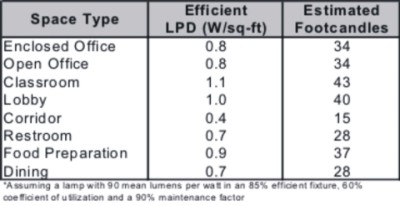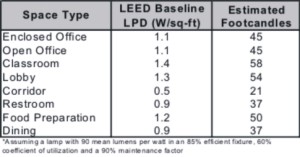
Cut the Lights!
Lighting systems typically account for at least 30% or more of the electric bill for most commercial and institutional buildings! This brief demonstrates how a modestly aggressive lighting design, can easily achieve two LEED® energy credits (points), and likely three points.
Buggy Whips and Abacuses
In the days of cheap energy, lighting design was much simpler than it is now. “Pound away!” [with lighting levels], was the creed of lighting design. Spaces were usually designed for blazing light levels that precipitated few complaints from owners and occupants. Offices and classrooms were often illuminated to at least 75 footcandles, which usually meant 4-lamp fluorescent fixtures on 8-foot centers (64 square feet, 1.7 Watts per square foot). For reference, the approximate light level of a typical big box store is between 60-80 footcandles.
Lattes and Laptops
In the days of carbon paper, typewriters and hand drawn plans, it was justifiable and perhaps necessary to provide 75 footcandles for office work. Today, routine daily tasks include significant use of computer screens, digital imaging, and high quality printed materials. For today’s classrooms and offices that are equipped with quality light fixtures casting uniform light throughout the space, 30 footcandles is sufficient to perform tasks effectively. Many designs however, still produce 50 footcandles. “All in favor of doing things the way we always do, raise your hand.”


New Codes and Standards
New lighting codes reflect the technological improvements that require lower light levels. The first table shows the current baseline lighting power density (Watts per square foot, or W/sq-ft) levels for LEED® energy credits. The estimated footcandle column shows what light level can be achieved with the given power density for each space. You can see that baseline power densities would result in levels that are “what we always do”.
Room for Improvement
The second table reveals the footcandle levels that can be achieved with a lighting power density that has been reduced by 25%.
As one can see, adequate light levels for today’s tasks can be achieved with power densities that would save substantial energy relative to LEED® baseline design. An aggressive lighting design might be worth three LEED® points, and more importantly, substantially reduced annual energy costs.




